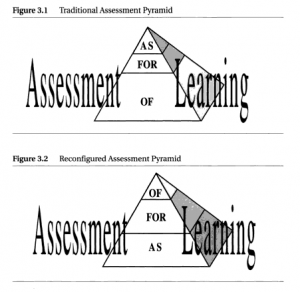This section concludes my inquiry proposal/plan. What remains now is to put this system into test mode this September, see whether or not the front load justifies the outcomes.
Introduction
Originally, this inquiry was focused on how one might objectively assess a student’s physical project based work with respect to prior knowledge they brought to the classroom, and also measure their growth in process with respect to the design wheel and social emotional development. The subject matter was chosen based on my experience at BCIT, where marks were constantly in question by the student’s as they were allegedly curved on subjective expectations relating to prior experience. For example, I was frequently assigned grades in the 80-90 percent range for decent though unspectacular projects, while the red seal carpenters in the group frequently scored high 70’s to mid 80’s for quite obviously superior work. This of course led me to ponder the inevitable dilemmas of how to grade student work under similar criteria, and how to justify those grades should my decisions come into question. I was and still continue to run on the assumption that many new teachers like me will run into similar dilemmas, so the inquiry has now focused down to creating a simple “handbook” that addresses key assessment strategies in a practical manner, and is adaptable to individual assessors needs.
I was relying on my long practicum to garner information and strategies to help with this project, but found that the focus on assessment at my school was very small, with the demographic dictating that connection with students to help them stay engaged in school as opposed to skipping and subsequently disappearing was paramount. This schoolwide focus left me cobbling bits of research, most of which belong to Kimberly Zumach from her Master’s dissertation on the new curriculum, and some practical strategies from the master teachers I worked with at the school. The actual handbook is something I will develop in the field this year, but the following descriptions will provide the initial framework, based on Zumach’s ideas and my field observations.
Key assessment areas
As outlined in the new BC curriculum, areas to be assessed include the core competencies, curricular competencies, big ideas, and content. In determining pertinent assessment methods it was necessary to alter the pyramidal focus hierarchy of “for, of, and as learning” (summative vs. Formative) to accommodate for the extremely high focus on safety, especially in technology education and the middle grades. The focus areas can easily be altered to accommodate more experienced secondary students throughout the process. This traditional model shows a shift in focus from assessment oflearning to asand for, but the safety component must follow a focus similar to the traditional model (fig. 3.1) as safety is a no-compromise mastery only concept in most areas of technology education. Beyond this safety element though, the reconfigured model of figure 3.2 is followed.

(image from a web page by Jessica Rome at: etec.ctlt.ubc.ca/510wiki/Assessment_as_Learning)
The key components to be assessed, along with the assessment type are summarized in the chart below for clarity:
| Assessed component | Suggested method(s) | Assessment type |
| Safety | Online quizzes or paper | Of |
| RD program (respecting diversity) | 9 step program | For/As |
| Employability | Rubric | For |
| Behaviour | Rubric | For |
| Project process | PBL/e-portfolio | As/For |
| Project completion | Instructor and self assessed | Of/As |
Although all of the above components are valuable, it is necessary to assign some form of weight to them in order of importance. The following chart is merely an outline to be altered as needed, but does give the basic idea of hierarchy of importance:
| Assessed component | Weight % |
| Safety | 45 |
| RD program (respecting diversity) | Not weighted |
| Employability | 10 |
| Behaviour | 10 |
| Project process | 30 |
| Project completion | 5 |
There is of course some inherent crossover here such as behaviour and employability within safety, respecting diversity within behaviour and employability, or the dependency of the project completion mark embedded in the process.
Methods
In delivering the instructional material, I have decided on the following methods:
- Teacher centric instruction
- Summative safety assessments
- Rubrics
- Project based learning
- E-portfolio
The following is a short summary of each method, indicating how it falls into the overall assessment picture:
Teacher centred instruction
The respecting diversity program, or a condensed version of it, should be presented to the students as part of the initial class expectations. Rubrics on behaviour and employability can also be piggybacked on this program, and developed with the students to promote the first exercise in community classroom environment.
- Competencies addressed: Core
- Assessment type: Formative
Multiple safety demo’s for general shop, hand tools, and power tools will be a large part of the class term. During demo’s, questions should be posed to students, and students should be prompted to re-iterate the main points repeatedly until confidence and mastery is apparent.
- Competencies addressed: Core, curricular, content
- Assessment type: Formative
Formal safety assessments
These are exactly what they sound like – formal summative assessments to demonstrate mastery after repeated formative assessment within safety demonstrations. I prefer the online quizzes which teachers can customize to their needs, although paper is an equally effective medium and can be signed by both parties to prove mastery should liability issues arise
- Competencies addressed: Curricular, content
- Assessment type: Summative
Following these assessments, establishing protocols such as having students orally reiterate the key safety rules of a piece of equipment before first use are suggested (strongly encouraged).
- Competencies addressed: Core, curricular, content
- Assessment type: Formative
Rubrics
Many types of rubrics are possible in the tech ed realm, but I believe the following two to be of most use in generalizing the expectations of students in a shop environment: Employability and Behaviour.
- Competencies addressed: Core, curricular
- Assessment type: Summative and Formative, depends on use and integration
Additionally, specific rubrics for projects may be used as well. These should reflect the criteria for the e-portfolio parameters outlined below. Here, the focus should lie within the process, not the product so frequent formative assessments in line with the rubric should be apparent.
- Competencies addressed: Core, curricular, big ideas, content
- Assessment type: Formative and summative
See sample rubrics attached as second file
E-portfolio
The tie in factor for assessment lies in the presentation and utilization of the e-portfolio. There are several online formats available including MyEd, freshgrade, portfoliogen etc. My main contribution to this was in borrowing the HACCP assessment format (hazard analysis and critical control points), specifically the critical control points to give the students several checkpoints along the way to assess, correct, design/modify, and reflect. The idea here is that the curriculum and those who drive it have no interest in finished product, only process. My observations however are that students are VERY interested in finished products, so a focus on process, design, observation, corrections etc. serves both needs equally (ie: the finished product takes care of itself quality wise, if the process control points are utilized).
- Competencies addressed: Core, curricular, big ideas, content
- Assessment type: Primarily formative, with a self and teacher assessed final “summative” mark
Another key idea is that the learning process is self assessed and corrected by the students, utilizing an assessment as learning structure and meta cognition practice as they reflect on each CCP. The assessments also guide the teacher as assessment for learning, allowing modifications to be made if certain concepts come up continuously unclear and problematic.
Conclusions
As stated, this is an ongoing project. Using the framework outlined here, I will test, modify, and assess the usefulness of this assessment system in my first year of teaching this fall. Most of the observations were simply ideas that came to me as I watched the assessment process in action, but I owe a debt of gratitude to the 5 teachers I worked with this spring who’s ideas past and present contributed many of the nuances to the proposed system. Please find attached the power point presentation that breaks down the main ideas in a condensed format, adding a visual augment that hopefully clarifies the concepts.
